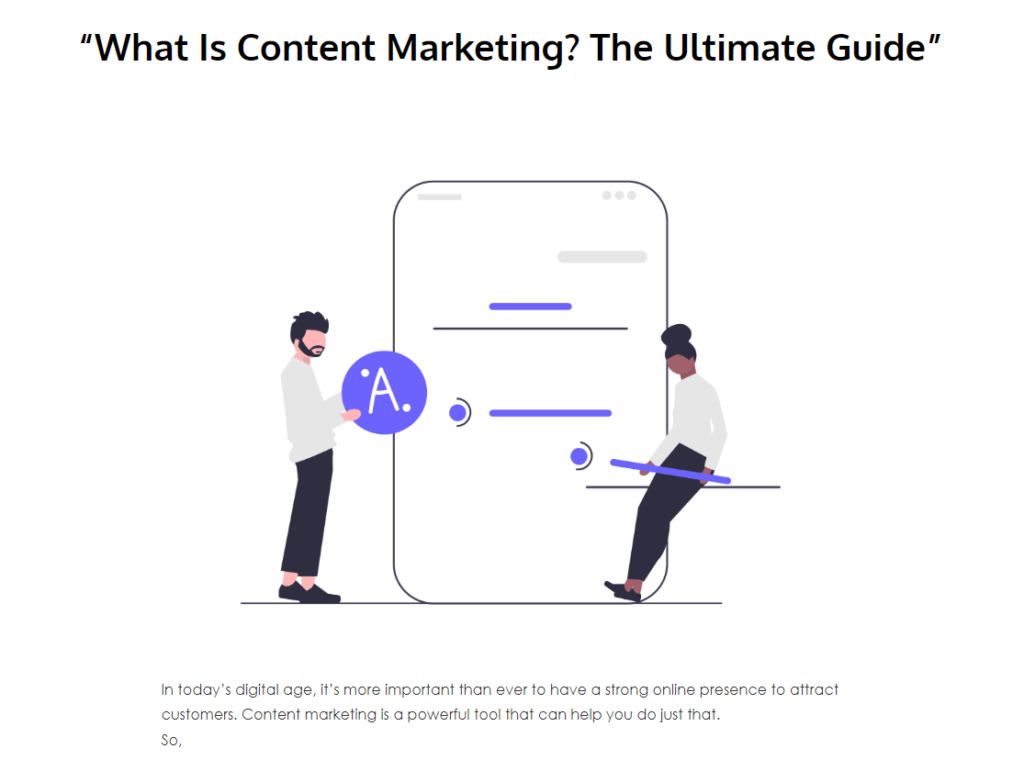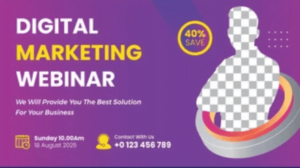In today’s digital age, it’s more important than ever to have a strong online presence to attract customers. Content marketing is a powerful tool that can help you do just that.
So,
What is content marketing?
Content marketing is a strategic approach to creating and sharing valuable, relevant, and consistent content to attract and retain a clearly defined audience – ultimately driving profitable customer action. In simpler terms, content marketing is about telling a story that resonates with your audience, so they want to hear more from you. It’s not about selling, it’s about building a relationship.
Content marketing can take many forms, including blog posts, social media updates, videos, podcasts, and more. The key is to create content that resonates with your target audience and provides them with something of value.
One of the biggest benefits of content marketing is that it can help establish your business as an authority in your industry. By consistently creating high-quality content, you can position yourself as a thought leader and build trust with your audience.
Another benefit is that content marketing can be more cost-effective than traditional advertising methods. While it may take some time and effort to create content, once it’s published, it can continue to attract and engage customers for months or even years to come.
Why does content marketing matter?
Content marketing matters because it helps businesses attract and engage with their target audience by creating valuable and relevant content that answers their questions and solves their problems. By providing helpful information, businesses can build trust and credibility with their audience, which can lead to more sales and loyal customers.
In today’s digital age, content marketing has become a crucial aspect of any successful marketing strategy. Here are some reasons why:
- Builds brand awareness: Content marketing allows businesses to showcase their expertise and provide value to their audience, thereby building trust and brand recognition.
- Increases website traffic: By creating high-quality and valuable content, businesses can attract more visitors to their websites, which can ultimately lead to more sales and conversions.
- Improves SEO: Search engines love fresh and high-quality content, which means that regularly updating your website with relevant content can help improve your search engine rankings.
- Engages with your audience: By providing content that resonates with your audience, you can create a strong emotional connection with them, which can lead to increased loyalty and advocacy.
- Generates leads: Content marketing can be used to capture leads by offering free content in exchange for contact information, which can be used for future marketing efforts.
Types of Contents
Content can come in many forms, and the type of content you create depends on your goals, audience, and the platform you’re using to share it. Here are some of the most common types of content:
1. Blog Posts:
Blog posts are written articles that can cover a wide range of topics. They can be educational, informative, entertaining, or a combination of all three. You’re currently reading one right now.

2. Infographics:
Infographics are visual representations of data or information. They can be used to simplify complex concepts or statistics and make them more accessible to your audience.
2. Videos:
Videos can be used to entertain, educate, or promote a product or service. They can be short or long-form and can be shared on social media platforms like YouTube, Facebook, or Instagram.
4. Podcasts:
Podcasts are audio recordings that can cover a wide range of topics, from news and politics to entertainment and lifestyle. They can be shared on platforms like Spotify or Apple Podcasts.

5. Social Media Posts:
Social media posts can take many forms, including text, images, videos, or a combination of all three. They are a great way to engage with your audience and promote your brand.
6. Ebooks:
Ebooks are longer-form content pieces that can provide in-depth information on a particular topic. They can be used to educate your audience and establish your brand as a thought leader in your industry.
7. Case Studies:
Case studies are in-depth analyses of how your product or service has helped a specific customer. They can be used to showcase the value of your offering and build trust with potential customers.
How to Develop a Content Marketing Strategy
- Know your audience: First, you need to figure out who your target audience is. Think about the people you want to reach with your content – what do they care about? What are their needs and interests? This will help you create content that speaks directly to them.
- Set goals: Next, you need to set goals for your content marketing strategy. What do you want to achieve? Do you want to increase website traffic, generate leads, or boost sales? Your goals will guide your content creation and help you measure your success.
- Choose the right types of content: There are many different types of content you can create – blog posts, videos, social media updates, infographics, and more. You’ll want to choose the types of content that will resonate with your audience and help you achieve your goals.
- Create a content calendar: Once you know what types of content you want to create, you can start planning out when and how often you’ll publish it. A content calendar will help you stay organized and ensure that you’re consistently publishing content.
- Measure success: Finally, you need to measure the success of your content marketing strategy. Keep track of your website traffic, engagement on social media, and other metrics to see if your content is resonating with your audience and helping you achieve your goals. If not, you may need to adjust your strategy and try something new.
Common mistakes to avoid in content marketing
- Not knowing your audience: If you don’t know who your target audience is, you won’t be able to create content that resonates with them. Make sure you do your research and understand your audience’s needs, interests, and pain points.
- Focusing too much on selling: Content marketing is not the same as advertising. If all of your content is just trying to sell something, people will quickly tune out. Instead, focus on providing value to your audience and building a relationship with them.
- Creating low-quality content: People have a lot of options when it comes to online content, so if your content is low-quality, they’ll quickly move on to something else. Make sure your content is well-written, informative, and engaging.
- Being inconsistent: If you’re not consistently creating and sharing content, it’s hard to build momentum and keep people interested. Set a schedule for yourself and stick to it.
- Not measuring success: If you’re not tracking your results, you won’t know if your content marketing strategy is working. Ensure you’re measuring website traffic, engagement on social media, and leads generated so you can see what’s working and what’s not.
Creating Content Buckets and Content Calendars
Content buckets are a way to organize the different topics or themes you want to create content around. Think of them like categories or folders on your computer. By creating content buckets, you can make sure that you’re covering a variety of topics and staying focused on your overall goals.
A content calendar is a schedule that outlines when you’ll create and publish content for each of your content buckets. It’s like a roadmap that helps you stay on track and plan ahead. By using a content calendar, you can make sure that you’re consistently producing content and that your content is aligned with your overall marketing strategy.
By using content buckets and content calendars, you can stay organized, focused, and on track with your content marketing goals.
Tools for Content Marketing:
There are many tools available for content marketing, and they can be grouped into several categories:
- Content creation tools: These include tools for creating and editing content such as graphics, videos, and written content. Examples: Canva, Adobe Creative Suite, and Grammarly.
- Content management tools: These help you manage and organize your content, including scheduling and publishing. Examples: Hootsuite, Buffer, and WordPress.
- Analytics tools: These allow you to track and measure the success of your content, including engagement, traffic, and conversions. Examples: Google Analytics, SEMrush, and Moz.
- SEO tools: These help you optimize your content for search engines, including keyword research and optimization. Examples: Ahrefs, Yoast, and Google Keyword Planner.
- Collaboration tools: These help you collaborate with others on your content marketing efforts, including content ideation, creation, and feedback. Examples: Trello, Asana, and Google Docs.
Conclusion
In conclusion, content marketing is an important strategy for businesses to attract and engage their target audience. By creating valuable and relevant content, businesses can build relationships with their customers and establish themselves as trusted experts in their industry.
Content marketing can also help businesses increase website traffic, generate leads, and ultimately drive sales. It’s a cost-effective way to reach people and build brand awareness.
Therefore, businesses should invest in creating high-quality content that speaks directly to their target audience. This could include blog posts, videos, social media updates, and more. By providing value to their audience, businesses can stand out from their competitors and build long-lasting relationships with their customers.
So, if you’re a business owner or marketer, I encourage you to invest in content marketing and start creating valuable and relevant content for your audience today!







